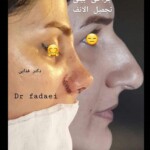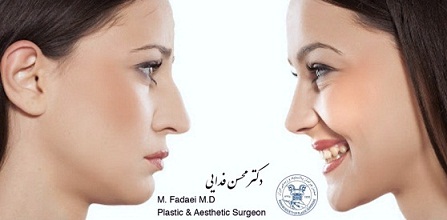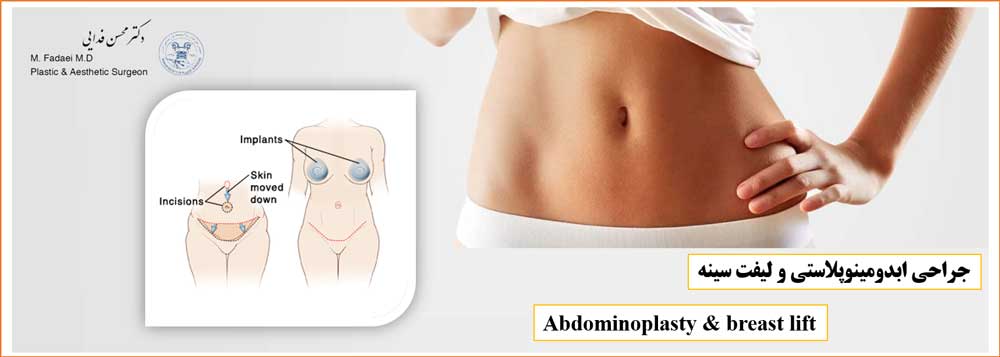It is noteworthy that the techniques used for nasal surgery are very advanced and it does not matter if you have a bony nose or a fleshy nose, in any case, a skilled nose surgeon can shape your nose in the best way possible to fit your face.
Types of nose:
One of the factors affecting nose cosmetic surgery is the type of nose, which is divided into two types of fleshy (meaty) nose and bony nose based on the amount of skin thickness.
Bony nose Cosmetic Surgery:
In the bony nose, the nasal skin is thinner, there is less fat and it’s not acne-pron. In this type of nose, the cartilage is larger and more robust.
People who have bony noses can undergo a variety of natural nose surgery, fantasy nose surgery. It is easier to work on the bony noses when nose surgery is performed because of cartilage-bony abnormalities, because they have more cartilage that is easier to repair, in which case the doctor will reduce the volume of the nose and forms it in the perfect form.
Bony noses are the most ideal nose for nose surgery because of features such as thin skin and strong bones, and most of the time in these noses surgery good results will be achieved.
What is the best procedure for nasal surgery?
The best method is to remove only that part of the cartilage or bone that causes breathing problems or apparent disharmony, and maintain the rest to achieve the desired result both aesthetically and in respiratory function.
One of the main characteristics that is important for Dr.fadaee in nasal surgery is the special attention to the nasal breathing function in addition to the appearance of the nose.
Mostly think that there’s no problem in result of bony nose surgery, and most of the time, the results are acceptable.
Which factors effect on the result?
Are the results positive and acceptable?
What is the bony nose?
Before answering these questions, first we discuss the structure of the nose. Nose consists of bone and cartilage. If the nose has hump and tight cartilage, this kind is called bony or cartilaginous nose.
Hump can be related to a damage, such as breaking in childhood, or hyper-growth of nasal bone and cartilage.
In these cases, removing bone and cartilage cannot help to beauty, rather the recovery is needed.
Skin and the soft tissue that covers the bone and cartilage, is an important part of nose. It’s important to know how the thickness of the skin influences the result of rhinoplasty.
If the skin be too thick, tip of the nose being round and if the skin be too thin, sub cutaneous irregularities can be visible.
Flexibility is another important factor. The skin with high flexibility, sticks to its following tissue and to shape the nose better, while, weak skin has more round tip with prolonged swelling. In this case, keeping the proportion of nose with other part of the face is so important.

Bony nose Cosmetic Surgery
People who are discontent with their nose, refer to doctor. Having hump and bulge due to the genetics or hereditary reasons, are as characteristics of bony noses. In some cases, damages can create the hump which can be seen from profile.
Best rhinoplasty surgeons:
Choosing the right surgeon is the most important decision you can make when considering rhinoplasty. In some cases, people easily decide to perform Bony nose rhinoplasty due to offering their friends and relatives, so they trust the doctor and choose that one.
The other way, is referring to doctor and consultation with patients. In clinic, you get familiar with older patients who performed rhinoplasty there and can ask your questions. In this case, it’s better for you to see their previous photos and compare them.
Rhinoplasty procedure:
In bony nose rhinoplasty, surgeon removes the cartilage and bone to shape the nose. At first, the surgeon creates incisions to get the cartilage and bone and then, removes the hump.
Cost of the performing Bony nose rhinoplasty depends on the procedures during the surgery.
Is there the possibility of reversion?
Doing after take cares, have directly impact on the result. With regarding the considerations, you will never have problem, and all symptoms such as bruise and swelling is removed.
The final result of the surgery may not be completely evident until several months after the nose surgery, most patients look better than before surgery right when the cast comes off.
AFTER SURGERY CARE GUIDE:
Applying cold compress for the first 2 or 3 days each quarter.
Taking a bath after nose surgery: the splint or bandage places on the nose for 1 week. If the bandage becomes wet, the possibility of falling the bandage is increased, which affect directly on the result.
Prescript drugs: these drugs, such as antibiotics, calmatives, adult colds and nose drop and dexamethasone is used, to reduce swelling, and should use after 6 hours and with a diet.
Nose massaging: putting your hand on both sides, and massage the nose from up to down. Put your stress on the bony parts. Massaging should be such that the nose draws to cheek.
The healing process after nose surgery requires time and patience. It is as important for you to be actively involved in after-surgery care and the operation itself is.
Please implement the following measures. Do not hesitate to ask your doctor if there is anything you do not understand.
Because of the pads in your nose you may be unable to breathe through your nose when you leave the operating theater. You must continue to breathe through your mouth during this period. Your doctor will tell you how long the pads must remain in place.
It is important to take in sufficient fluids. Fruit juice, water and soft drinks sipped gently will go some way to reducing the dryness caused by breathing through your mouth. Do not use straws. Eat soft, easily chewable foods. Use gels or lip creams to keep your lips moist.
Only use drugs prescribed by your doctor. Do not take aspirin or drugs containing aspirin or drugs that prevent blood clotting.
If the dressings on your nose are still in place, sleep or rest with at least two pillows under your head. Try to keep your head upright as much as possible during the day; this will preserve normal blood circulation and help reduce after-surgery swelling.
Some degree of nose swelling is to be expected. This will be pink or light red, but if red blood keeps appearing, then you must notify your doctor by telephone.
On leaving the operating theater there will be two layers of plaster and a plaster brace on your nose. These are as important for protecting your nose as for shaping it. Do not touch or alter these dressings; your doctor will remove them inside a week.
The small pad beneath your nose can be changed when necessary (or even done away with entirely in the absence of any bleeding).
Do not rub your nostrils or attempt to blow your nose. “Keep your hands away from your nose” will be a good rule to follow. Be careful not to twist your nose. Wear clothes that button down the front. Avoid t-shirts or polo necks.
Brush your teeth carefully and use only a soft brush. Do not pucker your lips or try to raise your lower lip any higher than necessary.
For the first two weeks after surgery, avoid bending, stooping, lifting heavy objects (especially small children), strenuous exercise and sport.
Avoid exposure to direct sunlight for the first month.
When the external dressings are removed you will see a degree of swelling and discoloring in the surrounding tissue. Your nose may be swollen and tilted upward. This will resolve itself in due course.
You may feel a numbness at the tip of your nose and sometimes in your upper lip. This will disappear in a few weeks.
Once the pads have been removed you can gently clean your nose 2-3 times a day using cotton buds and tap water. Do not thrust the cotton bud upward through the nostril.
Your nose will be blocked, even after removal of the pads. This is a normal tissue response to surgery. Do not try to blow your nose for a week. If you blow your nose, do so very gently. Do not use nasal sprays or drops. If you have to sneeze, do so with your mouth open.
Fatigue and weakness are common after the tranquillizers or anesthetics you were given during surgery. You will feel stronger in a few days. Sleeplessness may sometimes arise. You can be prescribed sleeping pills for the first week to help you sleep.
Depression is by no means uncommon between 12 and 36 hours after surgery. The first sight of your nose after surgery may come as a shock. Remember that you must be patient and realistic. Do not forget that your nose has undergone a surgical procedure and that it will improve with time. It may take between 6 and 12 months for your nose to heal entirely.
You may return to your normal professional life once the dressings have been removed (depending on the kind of work you do). Make-up can be used to cover up small bruises.
Be sure to attend all your appointments after surgery. These are essential for your doctor to monitor healing and the progress of your nose and for photographs to be taken to monitor improvements in your appearance after surgery.
Do not use spectacles for the first two months after surgery unless you have to. They may only be used when the plaster wire is in place. After that, they should be attached to your forehead with a piece of tape. You will be shown how to do this.











